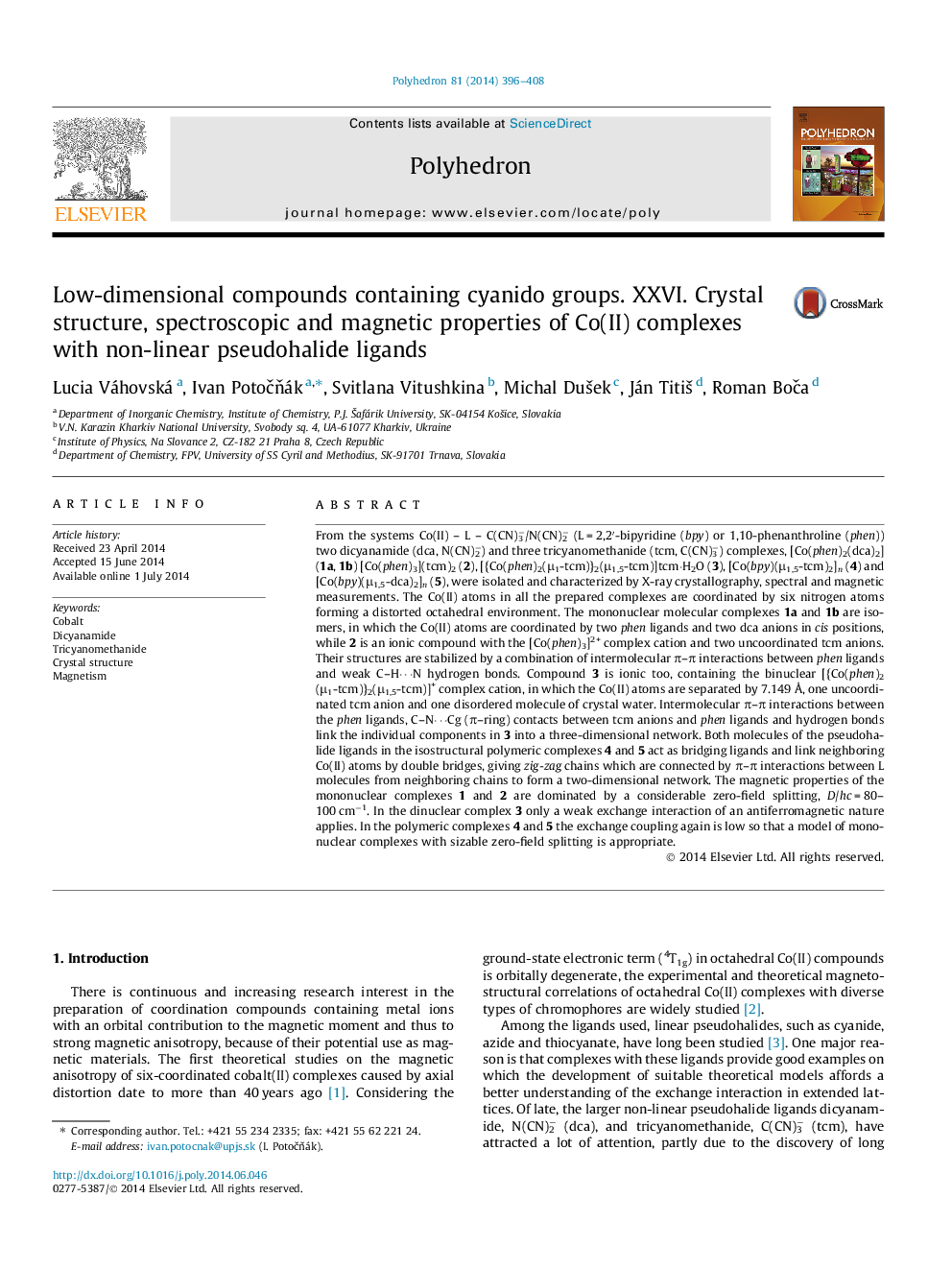| کد مقاله | کد نشریه | سال انتشار | مقاله انگلیسی | نسخه تمام متن |
|---|---|---|---|---|
| 1334445 | 1500258 | 2014 | 13 صفحه PDF | دانلود رایگان |

From the systems Co(II) – L – C(CN)3−/N(CN)2− (L = 2,2′-bipyridine (bpy) or 1,10-phenanthroline (phen)) two dicyanamide (dca, N(CN)2−) and three tricyanomethanide (tcm, C(CN)3−) complexes, [Co(phen)2(dca)2] (1a, 1b) [Co(phen)3](tcm)2 (2), [{Co(phen)2(μ1-tcm)}2(μ1,5-tcm)]tcm·H2O (3), [Co(bpy)(μ1,5-tcm)2]n (4) and [Co(bpy)(μ1,5-dca)2]n (5), were isolated and characterized by X-ray crystallography, spectral and magnetic measurements. The Co(II) atoms in all the prepared complexes are coordinated by six nitrogen atoms forming a distorted octahedral environment. The mononuclear molecular complexes 1a and 1b are isomers, in which the Co(II) atoms are coordinated by two phen ligands and two dca anions in cis positions, while 2 is an ionic compound with the [Co(phen)3]2+ complex cation and two uncoordinated tcm anions. Their structures are stabilized by a combination of intermolecular π–π interactions between phen ligands and weak C–H⋯N hydrogen bonds. Compound 3 is ionic too, containing the binuclear [{Co(phen)2(μ1-tcm)}2(μ1,5-tcm)]+ complex cation, in which the Co(II) atoms are separated by 7.149 Å, one uncoordinated tcm anion and one disordered molecule of crystal water. Intermolecular π–π interactions between the phen ligands, C–N⋯Cg (π–ring) contacts between tcm anions and phen ligands and hydrogen bonds link the individual components in 3 into a three-dimensional network. Both molecules of the pseudohalide ligands in the isostructural polymeric complexes 4 and 5 act as bridging ligands and link neighboring Co(II) atoms by double bridges, giving zig-zag chains which are connected by π–π interactions between L molecules from neighboring chains to form a two-dimensional network. The magnetic properties of the mononuclear complexes 1 and 2 are dominated by a considerable zero-field splitting, D/hc = 80–100 cm−1. In the dinuclear complex 3 only a weak exchange interaction of an antiferromagnetic nature applies. In the polymeric complexes 4 and 5 the exchange coupling again is low so that a model of mononuclear complexes with sizable zero-field splitting is appropriate.
Five Co(II)-L-X complexes, where L = 1,10-phenanthroline (phen) or 2,2′-bipyridine (bpy) and X = dicyanamide (N(CN)2−) or tricyanomethanide (C(CN)3−) anions, have been synthesized and characterized by single crystal X-ray diffraction studies. The dca and tcm anions exhibit monodentate or μ1,5-bidentate bridging modes. In two complexes, tcm acts as a counter-ion, too. The magnetic properties of all the complexes are discussed.Figure optionsDownload as PowerPoint slide
Journal: Polyhedron - Volume 81, 15 October 2014, Pages 396–408